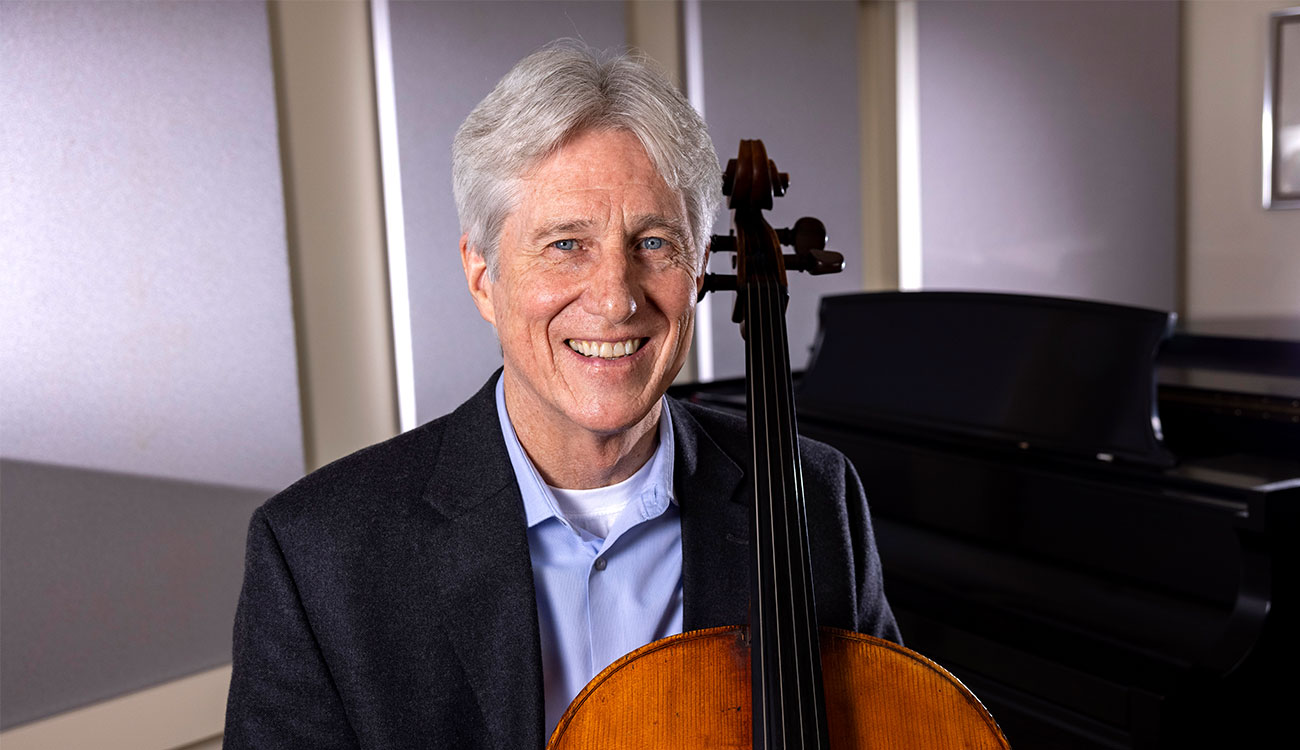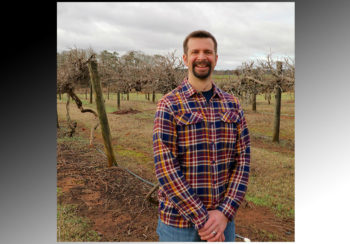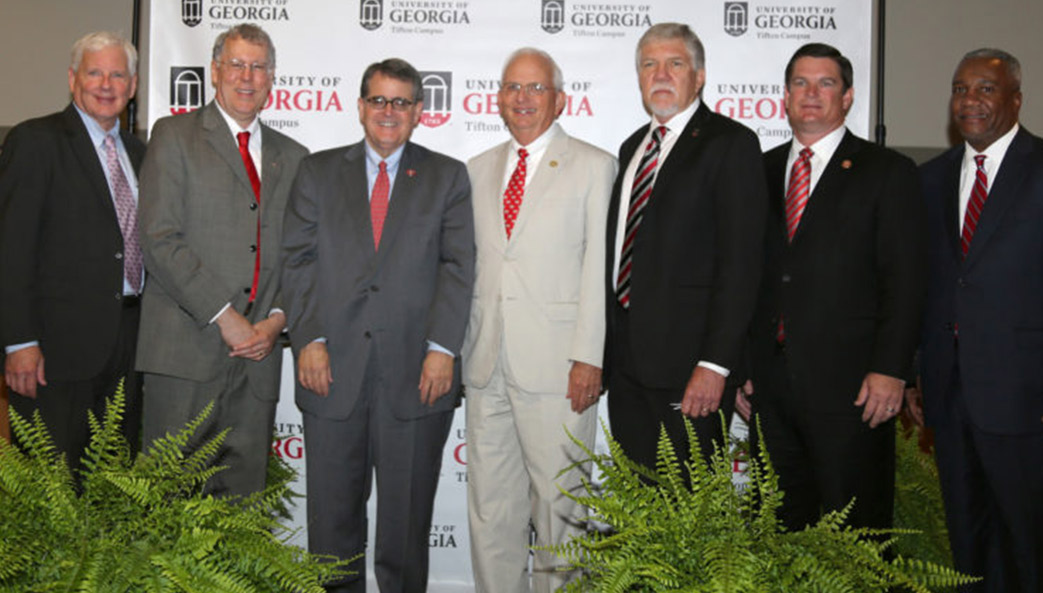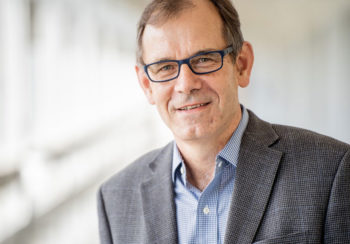David Starkweather is the professor of cello in the University of Georgia’s Hugh Hodgson School of Music, housed within the Franklin College of Arts and Sciences, where he has been a faculty member since 1983. In this interview, Starkweather discusses the role that cello has played in his life and how he uses technology to unlock centuries-old musical mysteries.
How did you become interested in the cello?
I started playing in the fourth grade. My school had just started a string program, and by the sixth grade I was the only one playing cello. I started taking private lessons, but I wasn’t really thinking about it being a potential career until my freshman year of college at University of California, Davis. I won the campus concerto competition that fall, which surprised me, and the following spring I did a full-hour recital. That’s when I began applying to conservatories and was accepted at the Eastman School of Music in Rochester, New York.
During that time, I participated in different summer programs—I think it’s critically important for budding musicians to be involved in their work during the summer—and I also had the chance to meet Bernard Greenhouse, a celebrated cellist. He was a wonderful mentor and a great guiding force for me. I also had the chance to study with Pierre Fournier, another celebrated cellist, for a period of six months in Switzerland. These were just a few of the experiences that molded me as a cellist.
Can you talk about the particular cello you play?
I’ve played my current cello since I was a student at Eastman in 1975. I’d made a couple trips to New York City to find a good cello, and I fell in love with this one instantly. It was originally crafted around 1840. It was made in Paris by the premiere French cello maker, Jean Baptist Vuillaume, and brought over from England when I found it. It’s still in beautiful condition, and I’ve been extremely lucky to have such a superb instrument.
What are some of the biggest changes you have seen on campus since joining the Hugh Hodgson School of Music in 1983?
The most dramatic change was the construction of the School of Music building on River Road in 1996. My previous office had been converted from a dormitory room in Joe Brown Hall. It had a nice high ceiling but an air conditioner in the window, which made it difficult for teaching music. The new building really changed everything for us. The School of Music was also much smaller in terms of faculty. We had maybe 32 faculty members then. Now we have more than double that. Everything has grown, including the number of students enrolled, and it’s been very rewarding to be a part of it.
You are internationally known as a consummate interpreter of Johann Sebastian Bach’s “Six Suites for Violoncello Solo.” What inspired you to pursue this work?
I think it came from my first teacher, Richard Anastasio, who loved Bach’s music. He taught me from an early age an interpretational approach to Bach so that I felt comfortable with the style.
A scholarly approach is especially critical with Bach, since much of the music in his original hand has long been missing. We have to rely on copies, and some of the copyists were quite inaccurate, as becomes obvious if one compares with the original work.
My research has included tracing the lineage or “filiation” of the music by identifying obvious mistakes and tracing where they were copied. My work focusing on Bach’s six suites has resulted in a 614-page document that compares the various sources. I would say this publication has been the biggest accomplishment of my career thus far.
In 2022 you won a UGA Creative Research Award. What was that experience like?
I was quite happy with that award, especially since it was in recognition of my work to interpret Bach’s six suites and the resulting 614-page pdf edition. During the application process, there were several letters from outside references who made it very clear it was something that could impact the entire cello world in terms of interpretation of the suites. Other instruments play the suites also—violinists, violists, bass players, guitarists; even trombone and marimba. While I’m not sure they’re going to consult my edition, my conclusions and discoveries might trickle down eventually. So this award was a welcomed recognition of my work.
Much of your work has focused on making classical music more digitally accessible. How do you approach technology?
I grew up in a family where we were using computers in their infancy. My father was a professor of psychology at the University of California, San Francisco, and he was the director of that campus’ computer center for many years. We had reams of computer paper and punch cards in the garage because at that point these were immense computers that ran on punch cards. So, I grew up with an early knowledge. That has helped me apply technology through my music work. The computer is a tool that can help you do other things, and there’s plenty of application in music. I did all the digital editing for my DVD set—which won me a UGA Creative Research Medal in 2009—and for two other CDs recorded with pianist Evgeny Rivkin. Overall, incorporation of technology depends on one’s aptitude, inclination, and training. Modern technology can certainly help us better appreciate, study, and compose music.
Are you involved in any collaborations with other musicians at Hodgson and beyond?
I have various collaborations with professional cellists in other institutions, and I sometimes get invited elsewhere to perform or teach. Here, though, most of my collaborations center around my string colleagues. We often prepare chamber music concerts, usually presented in Ramsey Hall of the UGA Performing Arts Center. In fact, there was one recently with Levon Ambartsumian, one of our violin professors. I also frequently work with another violinist on our faculty, Michael Heald, to organize chamber music. In addition, for the past two years I’ve been playing principal cello in the Augusta Symphony. I’ve been on concert tours with bass professor Milton Masciadri to Brazil, Argentina, Italy, and Serbia. I toured Brazil with violin professors Levon Ambartsumian and Shakhida Azimkhodhaeva, and piano professor Evgeny Rivkin. And I’ve played and taught twice in South Korea and twice in Peru.
Looking back, what’s been the biggest challenge of your career?
It’s hard to put my finger on it, but I’d say there’s an innate challenge in playing the cello. And that’s something that I enjoy: figuring out ways to overcome that challenge, because it’s all based on physical principles. You want your finger to push the right place on the string and your bow to pull at the right speed, placement, and weight. There’s a lot involved in doing it just right, and there’s the human factor. None of us can do things perfectly every single time. And then there are the aspects of accuracy, expression, and live performance.
How have you worked to train the next generation of cellists?
One of the most important traits is self-motivation. It also depends on where a student is coming from. Playing a string instrument usually needs to start at a pretty young age. A late starter has a lot more to overcome in terms of developing the coordination and technical setup. What I teach with students who are not as advanced is how topractice to get results. My teaching also emphasizes style: the length of particular notes or getting certain tone quality, and finding the character of the music.
I’m optimistic for the next generation of cellists. The YouTube and pdf era has made it incredibly easy for people to see how the instrument is played and how a particular piece might be interpreted. When I first came to Georgia, it was something of a string instrument desert. That was the case across the Southeast. But now several students I have taught over the years are directing their own string programs in Georgia, and that’s very exciting to see. These programs are all growing, and there are many more youth orchestras than there used to be. That’s a very encouraging sign.






